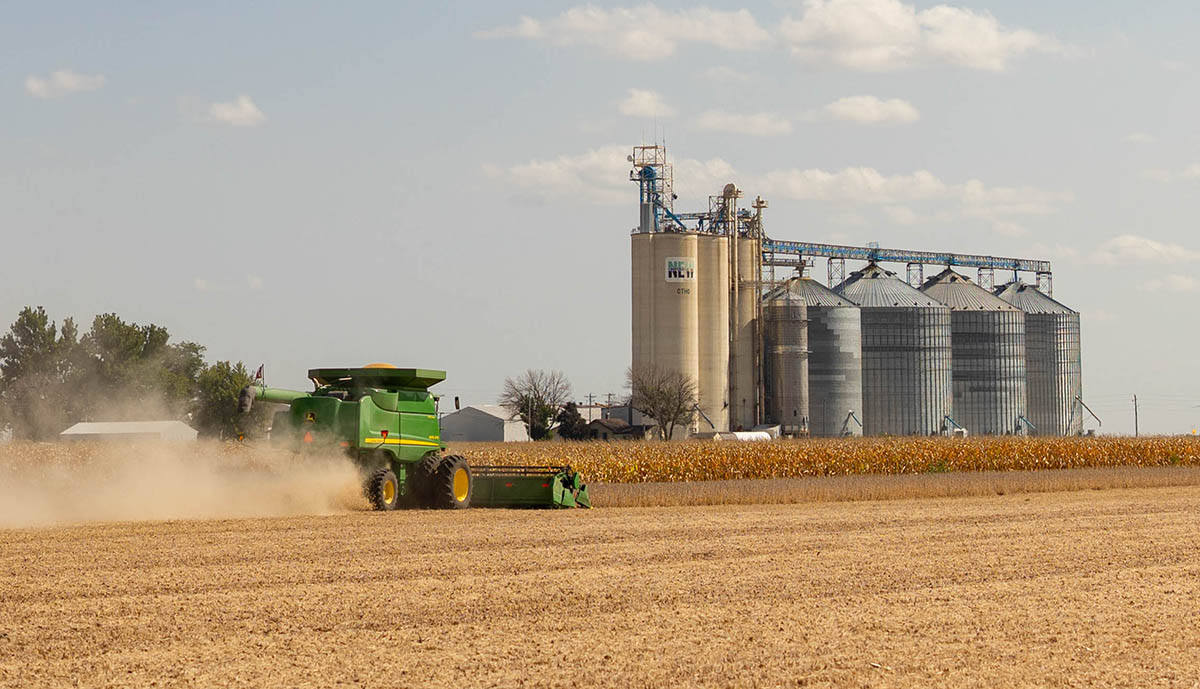
(Photo: Iowa Soybean Association / Joclyn Kuboushek)
Weathering uncertainty: StoneX talks markets, biofuels and the road ahead
October 16, 2025 | Bethany Baratta
If there’s anything certain in the current farm economy, it’s uncertainty. From government shutdowns to shifting trade flows and renewable fuel policy delays, there’s no shortage of challenges for today’s ag markets.
In a sitdown earlier this week with Jake Moline and Cooper Carlson from StoneX, input costs, trade and policy painted the picture of the conversation.
StoneX, a Fortune 100 company, is rooted in the Midwest, but has more than 70 offices worldwide. Much of the company’s work focuses on agriculture, especially in its West Des Moines office, where about half of its employees there work on the brokerage side.
“We consult grain elevators on how to manage basis and spreads. That’s where merchandisers make or lose money — and it’s been a tough environment the last few years,” says Moline, a risk management consultant for StoneX.
It’s been a tough environment for farmers, too, Moline acknowledged.
The U.S. Department of Agriculture (USDA) notes that since 2020, seed expenses have increased 18%, fuel and oil 32%, fertilizer 37%, and interest expenses more than 70%. An ongoing government shutdown, which began Oct. 1, has added another layer of uncertainty. Due to the shutdown, the USDA’s World Agricultural Supply and Demand Estimates (WASDE) report won’t be released. This means missed production data, leaving more questions than answers about supply, demand and yield expectations.
Trade tensions
You can’t talk markets without talking about the supplies on hand and its intended destinations and uses.
“By this point in the year, we’d normally have 500 million bushels of soybeans sold to China,” Moline says. “Right now, we’ve shipped zero.”
The slowdown in exports to China is weighing heavily on the soybean market.
“People say we’ll just sell them somewhere else, but that’s not how global trade works,” Moline says. “Every week we don’t move beans, we lose demand.”
The Iowa Soybean Association understands how the market affects farmer profitability. That’s why the association, via hosting or attending trade missions, has continued its efforts in reaffirming soybean trade relations with mature markets while building market share in developing and maturing markets. Soybean farmer leaders from Iowa have participated in recent trade visits to Korea, India, Japan, Egypt, Mexico, Vietnam, European Union, China, Morocco, Guatemala, Philippines, Chile, Costa Rica and Thailand, to name just a few.
Soy crush
The expansion of soybean processing in the U.S. has been driven by the growth in demand for renewable diesel. For the first time ever, biofuels use of soybean oil has surpassed oil used for exports or through domestic use in food consumption. As production of soybean oil grows, so, too, does soybean meal.
“We’re seeing more beans stay home,” says Carlson, a commodity economic analyst specializing in renewable fuels for the StoneX team. “Crush demand is helping offset some of the lost exports.”
If the planned crush capacity expansions are built by 2030, it would represent a 22% increase in domestic crush capacity since the beginning of 2023, according to the American Soybean Association.
The health of the crush industry and buildout of plants with longer timelines will depend on biofuel blending levels to be announced for 2026 and beyond, says Scott Gerlt, ASA’s chief economist. Favorable numbers would allow soybean farmers to receive increased value for their crop, Gerlt says.
Carlson says some export demand that may be lost may be picked up through domestic use.
“If we're trying to incentivize production at home (in the U.S.), be less reliant on our trade partners, seeing some demand from our trade partners dissolve … then we've got our politicians looking internally to see what we can do on the domestic side,” Carlson says.
Renewable fuels outlook
However, the fuels outlook remains clouded by policy delays. The Environmental Protection Agency’s (EPA) upcoming Renewable Volume Obligations (RVOs) for 2026 and 2027 could provide a boost for soybean oil demand. ISA advocates that the EPA’s proposed 5.61 billion gallons of biomass-based diesel volume obligations for 2026 (a 65% increase from 2025) be made permanent. Reallocating proposed Small Refinery Exemptions would also help the Iowa soybean industry to maintain its strength in the soybean oil market, as Iowa remains the nation’s leader in biodiesel production.
Uncertainty over implementation timelines, small refinery exemptions, and the effects of the government shutdown have created some hesitancy.
“The only constant in renewables is uncertainty,” Carlson says. “It’s hard to plan when the rules keep changing.”
Unsold, unprotected
For farmers, that uncertainty of the markets has real consequences. Many weren’t able to lock in profitable prices ahead of harvest.
“Usually there's at least one time where new crop futures trade above that spring crop insurance price between spring and fall,” Moline says. “That did not happen this year on one single day. Most of the bushels that are coming into an elevator this fall are unsold and unprotected.”
Because shipments aren’t moving to a once-dominant trading partner, storage space is tight. Cash flow is strained and interest costs are cutting into profitability.
“We’ve got a bumper crop, limited storage, and high costs,” Moline says. “Growers don’t have many good options right now.”
StoneX recently joined as a partner in the Iowa Soybean Association’s (ISA) Partners+ program. As a result, ISA members receive discounted registration to select StoneX programs and services.
Written by Bethany Baratta.
Back